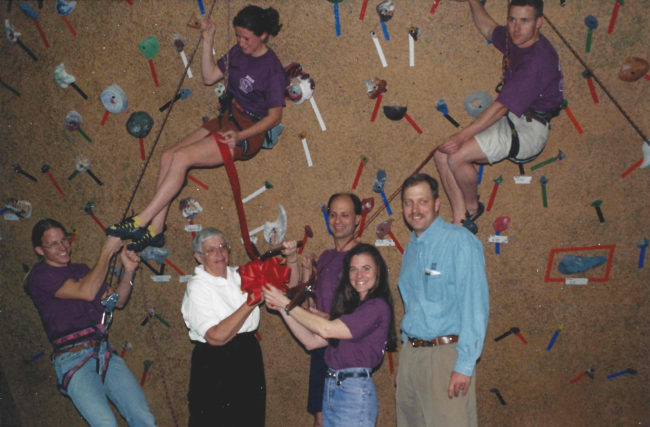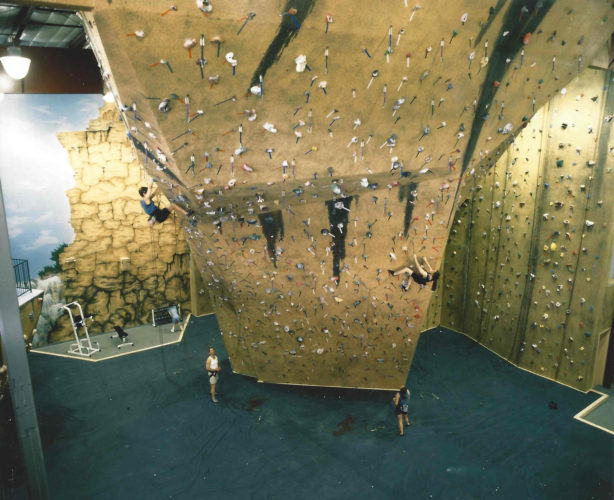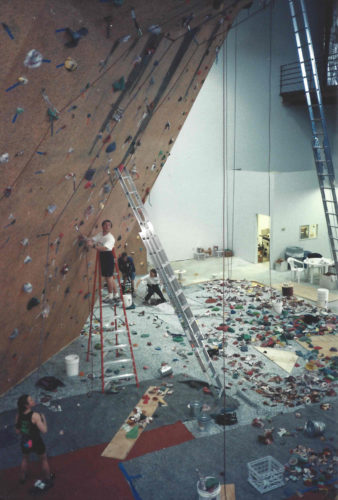Spotlight on the 90s is part of a recurring column that shines a light on the iconic gyms, brands and people from the beginnings of our industry. We love these old gyms, we cherish the memories, and we know you do too. Check back regularly for future installments of this ongoing series.

Gym: ROCK’n & JAM’n
Location: Thornton, Colorado
Opening Date: May 10, 1997
When John Kruse recalls the origins of the climbing gym that he and his wife would eventually open, the search for the right building is still a vivid memory. Kruse had recently quit his corporate job, an enjoyable-but-monotonous slog in middle management at a Colorado storage technology company. And he was also in the midst of trying to secure business loans from banks that did not know what the phrase indoor climbing meant. So, finding a suitable facility was just the latest in a long string of challenges, potential roadblocks, and conversations with doubters and naysayers. At the time, in the early 1990s, Kruse and his wife, Deb Grass, did not have the upfront capital to construct a climbing gym from the ground-up. So, they were working with a realtor to locate a suitable, preexisting site; in fact, they had already looked at 30 different buildings…to no avail.
Finally, one day in 1994, Kruse started driving around on his own, “just looking for tall buildings.” Eventually he came upon an alluring structure—a health club facility that had run out of money more than a decade prior. This would-be health club, stuck in financial mire in a small town called Thornton, had never even opened—so now its facade loomed in between Boulder and Denver like a beacon of unrealized potential. Construction of its second floor, originally intended to be a jogging track, had never been completed. Elsewhere, unused hot tubs sat overturned in the surrounding lawn gathering weeds and moss. Kruse was intrigued; he saw possibilities. He quickly called the owner of this health club building to inquire about the price, but the asking amount turned out to be too far out of range for Kruse and his wife. Perhaps the site, although brimming with promise, was destined to remain vacant and increasingly forsaken.
Nearly a year passed, but the dream of opening a gym never wavered for John Kruse and Deb Grass. A few friends eventually offered to chip in money. Grass, who was still employed as a software developer at the time, attended the Outdoor Retailer show and made some inroads in the climbing industry. And Kruse continued his search for an appropriate building. Then, on a whim one day, Grass suggested that her husband inquire again about that forsaken health club. Why not? In a bit of serendipity, Kruse probed and soon learned that the health club site had been sold to a new landlord who was more eager to find a tenant.
So, in that shell of a former health club, Kruse and Grass finally found a physical home for their ambition; they could now secure the property and get to work on repurposing the expansive building as a climbing gym. Yet, in time, the resulting ROCK’n & JAM’n facility would prove to be more than just a gym. It would become one of the most innovative and influential spaces in climbing’s storied history.

Breaking the mold
To fully understand the various ways in which ROCK’n & JAM’n would prove inventive, it is necessary to first know the backgrounds of creators John Kruse and Deb Grass. By the time they had secured that former health club building, they had only been climbing for a few years—Grass slightly longer than Kruse, who had endured a multi-year healing process from back surgery that negated most physical activities altogether for a while. When Kruse recovered and was finally able to start climbing frequently, the two became regulars at the original Boulder Rock Club. They had even considered investing in that gym when rumblings had emerged about the potential relocation of the Boulder Rock Club to a new site. But those thoughts had quickly evolved into a dream of opening their own gym—which would end up being ROCK’n & JAM’n. “I think hi-tech burnout was in the back of our minds, and one day I just said, ‘Why don’t we just open our own gym?’” Kruse recalls fondly. “And Deb considered it for about 10 seconds and then we decided to take the leap.”
It was that relative newness to climbing that inadvertently allowed John Kruse and Deb Grass to think outside-the-box, especially once receptive banks were found and construction of ROCK’n & JAM’n got underway in November of 1996. “We were not connected to the huge climbing community in the Boulder area,” explains Kruse. “We certainly weren’t known by the elite climbers either. Deb had made a few good contacts, but we didn’t know anything about starting a business—or a climbing gym.”
One such contact that would prove invaluable was that of the Pinnacle Group, whose services Kruse describes as “one-stop shopping” for would-be gym developers at the time. Pinnacle typically helped clients with the creation of financial forecast models and the development of gym plans, and they also worked in conjunction with a Colorado-based climbing wall builder called Leading Edge. Kruse and Grass ended up not utilizing Pinnacle’s full services, but they did correspond with them and hired Leading Edge to turn the interior of the former health club building into a state-of-the-art climbing gym.
Although Kruse and Grass lacked certain practical experience, they had made an exemplary decision in choosing the building site. Given the high ceilings (which had been designed originally to accommodate racquetball courts in the health club), Leading Edge was able to install a 37-foot-tall lead climbing wall—and fashion the walls with a cave design that overhung by 37 feet. This meant that ROCK’n & JAM’n would offer some of the tallest and most impressive lead climbing in the region upon completion. Even today, if ROCK’n & JAM’n is mentioned to climbers who were part of the scene in the 1990s, the gym’s immense lead wall is likely to be referenced in fond recollections.
But complementing the towering cave was that upper partial-floor that had been designed to be the health club’s jogging track. In a climbing gym context, this track could be turned into a mezzanine and, as Grass remembers, it would become “perfect for spectating” climbing competitions.

Tracking the customers
As jaw-dropping as the lead wall at ROCK’n & JAM’n was at the time, there would prove to be other, less noticeable innovations at the gym that would have greater impacts on the industry. Foremost among these was to be the implementation of a computer system to keep track of gym memberships. At a time when many other climbing gyms did not yet even have computers at the front desk, Kruse and Grass used their respective knowledge and backgrounds to make their gym among the most technologically advanced of its day.
“I was on the search for some type of software that could be modified to support climbing gyms,” recalls Grass. “There was nothing out there—and with my background in programming—I became our IT department, essentially. I found a company that had software called Gym Trax, which was for health clubs. I worked with a developer to modify it for climbing gyms so that it could track tests for top-rope and lead climbing. Our version was called Fitness Trax.”
Grass and Kruse borrowed another idea from the fitness world when they installed a camera at the front desk, similar to those used for creating passports. The results were photo identification cards—with scannable barcodes—that could be used for customers’ check-ins. This can all be seen as some of the very first computerized customer relationship management (CRM) protocol in a climbing gym, essentially contributing to the groundwork which Rock Gym Pro and other software that is standard at gyms nowadays would build on.
In fact, upon opening in May of 1997 by way of $200,000 in startup cash and a $200,000 bank loan, ROCK’n & JAM’n was considered a pioneer in practically every aspect of customers’ experience. For example, pea gravel was largely considered to be the industry standard for climbing gyms’ flooring at the time, as it was the playground standard as well and did a good job of impact weight dispersal. But pea gravel was extremely dirty and dusty indoors—something that virtually all gym operators from the 1990s will attest to. So Kruse once again thought outside-the-box, hopped in his car one day, and drove around in search of a solution. He eventually found a warehouse in Denver that had collected thousands of square yards of convertible Jeep top material. Kruse then found a different warehouse that was selling carpet padding in bulk. By combining the two materials, a makeshift padded floor could be created. “We had probably 15 layers of carpet padding, covered by the Jeep top material,” Kruse explains of the eventual flooring installation at ROCK’n & JAM’n. “Nobody else that I’m aware of had ever done anything like that at that time.”

ROCK’n & JAM’n was also an early adopter of auto belays, particularly because Eldorado, a climbing wall brand that was headquartered nearby, was a distributor of an auto belay called the Redpoint Descender. At first, the auto belays at ROCK’n & JAM’n were mobile—able to slide with ease to various routes throughout the gym on a track system near the top of the walls. This was convenient for route variety, but undesirable for belayed falls. So Kruse devised a braking system using climbing shoe rubber that made any slidable auto belay more stationary and much more stable during ascents and descents. Kruse also talked with a frequent ROCK’n & JAM’n customer named Greg Klinger about the development of a clever device called the Hangdogger—essentially an auto belay that did not lower the climber until the climber wanted to be lowered. Klinger had invented the device, and Kruse allowed prototypes to be tested at the gym. It was an enterprising idea, Kruse reflects, but neither Klinger nor Kruse were ultimately interested in setting up the necessary manufacturing…or navigating the requisite liability insurance for selling the novel device.
Over time, Kruse and Grass also pondered the subject of air filtration in the gym. They eventually installed a system behind the gym’s lead climbing cave that drew air in at the ground level, filtered it, and exhausted it atop the climbing walls. “Besides sucking out the chalk dust in the air near the floor, it moved cooler air from down low and distributed it up high, where it is always hottest,” Kruse says. He adds that some entrepreneurial customers even asked if they could find a way to recycle the chalk that had collected on the filters and resell it.

Creating a community legacy
Given such innovation, it was natural that the most elite climbers of the country would frequent ROCK’n & JAM’n, either to boulder around or session on the lead wall. Robyn Erbesfield and Lynn Hill were some of the most well-known climbers to pass through the front doors in the gym’s early days. Another customer—not quite as well-known at the time—was Colorado resident Tommy Caldwell, who was still just a teenager and climbing frequently with his father.
In fact, on the weekend of April 25-26, 1998, ROCK’n & JAM’n would gain national press by hosting an ASCF National Championship. At the event, Tommy Caldwell would place second in the men’s division behind another teenager—an uber-talented Californian named Chris Sharma. Katie Brown, yet another teenager, would win the women’s division in a field populated by Beth Rodden, Michelle Hurni, Bobbi Bensman, and other stars.
But if that big event shined a national spotlight on the gym, it was only reflecting what the locals of Boulder and Denver had already figured out: ROCK’n & JAM’n was a unique place. “I recall the gym feeling like one of the first that really approached the climbing gym as a business,” says Mike Pont, one of the most sought-after routesetters of the era, and someone who personally trained many of the facility’s first staff routesetters.

Over time, the gym expanded—from 7,400 square feet of climbable surface initially to 9,500 square feet. A second ROCK’n & JAM’n location was opened as well, in 2004. This newer gym, in Centennial, Colorado, offered slightly taller climbing walls (40-feet). It was also one of the first climbing gyms to embrace Ninja-type accouterments, predating the American Ninja Warrior broadcast (and national craze) by a couple years.
Indeed, the creation of the second gym marked the continuation of a business dream for Kruse and Grass, and the two continued to operate both ROCK’n & JAM’n facilities until an offer to buy the gyms “came out of the blue” in 2012. “Being there mostly all the time still, we were tired,” admits Grass. So a decision was made to sell both locations, although each facility is still in operation to this day under new management. In fact, Kruse and Grass still climb at ROCK’n & JAM’n frequently.
Asked about the gym, its legacy, and the 1990s, Kruse reflects, “Bumping elbows with the elite climbers was great, but what we really miss now is those couple thousand friends that we’d see seven days a week. We had people who got engaged at our gym, and friends who met at our gym.”
Grass adds, “We’re proud of it.”

John Burgman is the author of High Drama, a book that chronicles the history of American competition climbing. He is a Fulbright journalism grant recipient and a former magazine editor. He holds a master’s degree from New York University and bachelor’s degree from Miami University. In addition to writing, he coaches a youth bouldering team. Follow him on Twitter @John_Burgman and Instagram @jbclimbs. Read our interview Meet John Burgman, U.S. Comp Climbing’s Top Journalist.









